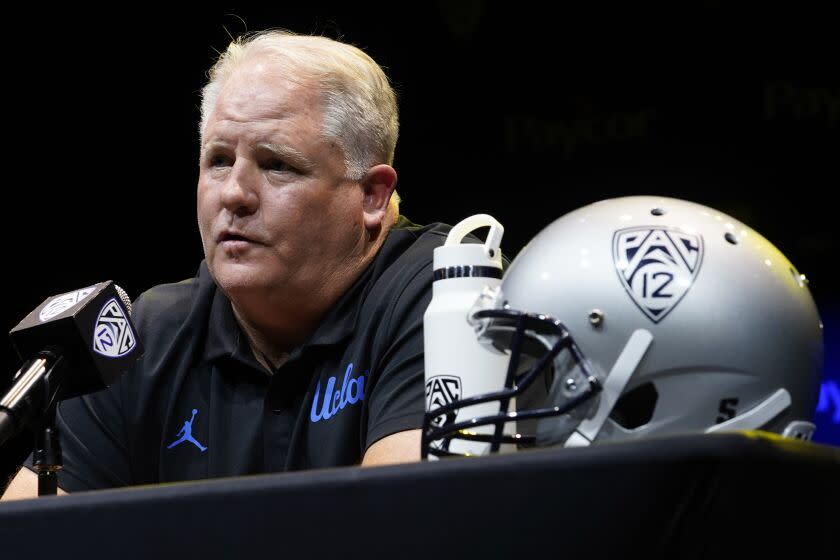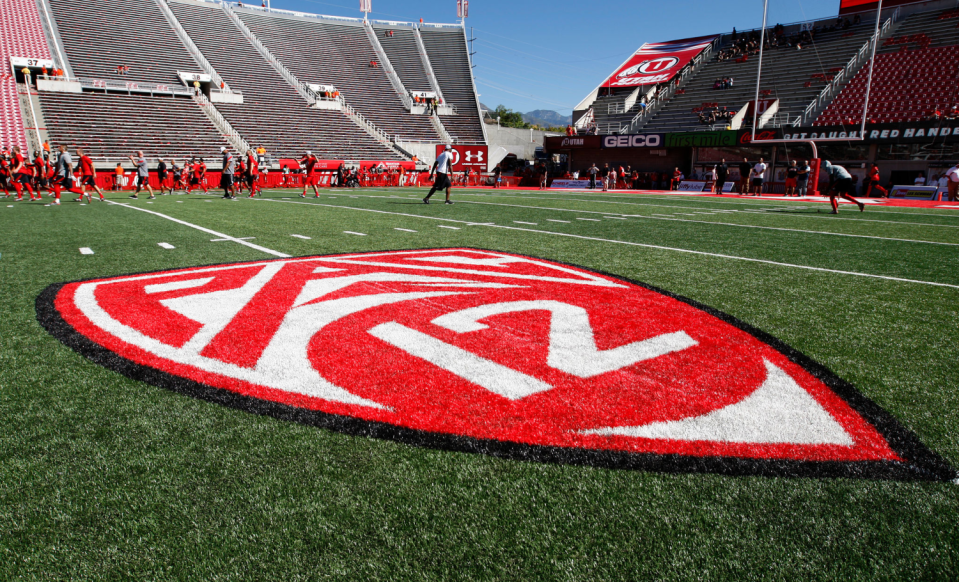Chip Kelly’s plan could save college sports, and that’s why it’ll never happen


The Kelly Plan. It has a nice ring to it, but it will never happen.
Chip Kelly’s idea about how to steer the college sports enterprise away from fully losing its soul — having top football schools be classified as independent and playing by their own rules, allowing the rest of the sports to be grouped together regionally as they used to be — is simply too logical for college sports leaders to wrap their heads around.
It’s also not a new concept. In December 2020, in the aftermath of college football’s disjointed and desperate attempt to play a season during a global pandemic, the Knight Commission said the best way to move forward would be to remove the Football Bowl Subdivision from the NCAA and let a new entity govern the sport’s highest level of competition.
Read more: Tired of nonstop realignment? UCLA’s Chip Kelly may have the common-sense solution
The commission, comprised of university presidents and former college athletics administrators, saw the same thing Kelly did last week as the Pac-10 suddenly became the Pac-4.
“I’m fired up for the Big Eighteen,” Kelly cracked Tuesday, referring to the Big Ten’s additions of Oregon and Washington.
It’s worth pointing out that the Knight Commission made its recommendation before the latest wave of realignment.
Before Texas and Oklahoma left the Big 12 for the SEC.
Before the Big Ten responded by taking USC and UCLA from the Pac-12.
Before the killing off of the West Coast’s power conference as we know it, with the Big 12 adding Colorado, Arizona, Arizona State and Utah after the Big Ten grabbed the Ducks and Huskies.
Before it was clear that West Coast nonrevenue sport athletes were going to be forced by their schools to play many of their road games two or three time zones away.
The Kelly Plan was mostly addressing the travel issues on a practical level.
“Our sport’s different than everybody else — we only play once a week,” Kelly said. “Travel’s not a big deal for football, but it is a big deal for other sports. So that’s my theory.”
But the differences are so much bigger than just travel demands. College football has ballooned into a multibillion dollar industry — and that’s just within one conference these days (the Big Ten’s new TV deal is for more than $1 billion per year).

Over time, the sport achieved this value — second to the NFL in our nation’s sporting imagination — because of its pageantry, the revelry of rivalries and the regional bragging rights won or lost every Saturday. Ironically, those are among the unique qualities that are now being tossed aside to max out the financial interest that sprung out of the traditions of yesteryear.
College football didn’t need Michigan playing USC or Oklahoma playing Florida in conference games to become popular. All it needed was Purdue always playing Ohio State extra tough for some reason, or Oregon State putting its regular scare into the Trojans. Not every team needed to be an obvious national TV ratings draw to deliver a great product, and the result was that fans of all schools remained passionately engaged with the sport as a whole.
An Oregon State fan was more likely to watch the Oregon-Washington game because the Beavers were competing for the top prize right along with them.
Now? Why would Oregon State, Stanford, Washington State and Cal fans care who makes the College Football Playoff? The majority won’t as time passes.
Read more: Oregon and Washington join Big Ten and Pac-12 is in peril. What happens next?
That sense of belonging to the big time is what sent Stanford and Cal asking to join the ACC earlier this week. Yes, you read that right — the Atlantic Coast Conference.
When I saw the report that there may be mutual interest, I thought, “This makes so little sense that it very well could happen.” That would be the inverse of my expectation with the Kelly Plan, which is that it makes too much sense to be considered viable in today’s college sports landscape.
Now controlled by the purse strings of Fox, ESPN and other networks, this is how far gone college sports are: If not for a few ACC schools deciding to vote no on Cal and Stanford this week, the Golden Bears and Cardinal were going to be toting their “student-athletes” across the country just to be a part of a “power conference” that is likely to be the next to be ripped apart.
The reason, say, Florida State presumably did not want Cal and Stanford in their conference wasn’t the absurdity of the premise. It was because the Seminoles are angling to get out of the ACC as soon as possible so that they can hop on the Big Ten gravy train, too. (If a Big Ten school residing in Tallahassee, Fla., is shocking to you, just remember Fox would love to get the conference into the Florida marketplace).

Florida State, similar to USC before it left the Pac-12, does not see any reason to add less valuable schools to the conference it’s stuck in.
So, now Cal and Stanford wait, along with Washington State and Oregon State. The Pac-4 could merge with the Mountain West or possibly be eaten by it. The Cardinal could go independent, joining their pal in pomposity, Notre Dame.
The Kelly Plan could save the day. It was refreshing to hear someone inside the machine cut through the noise so clearly.
Was the NCAA listening? It definitely hasn’t done much to respond to the Knight Commission’s recommendation from nearly three years ago.
How about this: Instead of badgering lawmakers on Capitol Hill about getting control of name, image and likeness payments to players that bring in the billions for the schools, the NCAA could use the Kelly Plan as a basis to push for a bill that works to preserve what’s actually special about college sports. Hint: it’s not that the players aren’t paid.
Read more: UCLA and USC will join the Big Ten in one year. This is their plan for an elite move
To accomplish anything close to reform that gets to the heart of the issues, college sports would need bold leaders who are willing to deconstruct the system that they and their peers have been busy building for decades now. Yes, that sounds implausible, but it seems like nobody is even trying. The ending to this story doesn’t have to feel so inevitable, like this slow, alienating death march toward … what exactly? Oh, right. More money.
There’s no turning back now. It took a football coach presenting a hopeful plan to make it clear to me that there’s no hope left.
This story originally appeared in Los Angeles Times.
